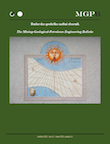Contribution to the methodology of determining the optimum mud density - a case study from the offshore gas condensate field D in the Persian Gulf
DOI:
https://doi.org/10.17794/rgn.2018.4.9Keywords:
time-dependent well bore instability, shale formations, effective hoop stress, mud densityAbstract
Drilling the wells using water based mud through shale formations, causes their exposure to serious time-dependent wellbore instability due to shale swelling. Operating companies, before drilling operations through demanding shale formations, usually conduct drilling fluid optimization studies in order to define the proper mud type, mud density, salt type and concentration for inhibition. Through the analysis of offset wells, they are interpreting data about mud filtrate breakouts into the rock formations and chemical potential mechanisms to understand their influence on the time-de- pendent wellbore instability. The main objective of this paper is to give an insight in time-dependent and mechanical wellbore instability problems faced while drilling the wells through different shale formations in the gas condensate field D in the Persian Gulf. The importance of drilling fluid design optimization and solutions applied to overcome hole in- stability problems were analysed and highlighted. Besides the development of a model for mud density calculations, a concept of effective hoop stress and its influence on time dependent failure mechanisms is discussed. As a contribution to the method improvement, mud density calculation is verified by taking into the consideration the relationship be- tween pore pressure and effective hoop stress and it is based on measured data from Well A in gas condensate field D from the Persian Gulf.
Downloads
Published
How to Cite
Issue
Section
License
Copyright (c) 2018 Rudarsko-geološko-naftni zbornik

This work is licensed under a Creative Commons Attribution 4.0 International License.
Creative Commons-BY
Authors who publish with this journal agree to the following terms:
In agreeing this form, you certify that:
- You read the ethical codex of the RGN zbornik available at journal web.
- You submitted work is your original work, and has not previously been published and does not include any form of plagiarism.
- You own copyright in the submitted work, and are therefore permitted to assign the licence to publish to RGN zbornik.
- Your submitted work contains no violation of any existing copyright or other third party right or any material of an obscene, libellous or otherwise unlawful nature.
- You have obtained permission for and acknowledged the source of any illustrations, diagrams or other material included in the work of which you are not the copyright owner.
- You have taken due care to ensure the accuracy of the work, and that, to the best of your knowledge, there are no false statements made within it.
- All co-authors of this submitted work are aware of, and in agreement with, the terms of this licence and that the submitted manuscript has been approved by these authors.
Publication licence
You retain copyright in your submitted work, according to journal license policy (CC-BY). By signing this form you agree that RGN zbornik may publish it under the publication licence. In summary the licence allows the following:
Anyone is free:
- To copy, distribute, display, and perform the work.
- To make derivative works.
Under the following conditions:
- The original author must always be given credit.
- The work may not be used for commercial purposes.
- If the work is altered, transformed, or built upon, the resulting work may only be distributed under a licence identical to this one.
Exceptions to the licence
In addition to publishing the work printed under the above licence, RGN zbornik will also enable the work to be visible online.
The journal editorial can change the licence rules anytime but it cannot retroactively restrict author(s) rights.


